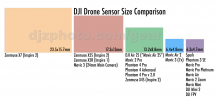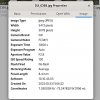You are using an out of date browser. It may not display this or other websites correctly.
You should upgrade or use an alternative browser.
You should upgrade or use an alternative browser.
Anybody know Mavic Air 2s Camera Specs?
- Thread starter DavidBlezard
- Start date
jedpause
Well-Known Member
- Joined
- May 13, 2018
- Messages
- 93
- Reactions
- 41
If you read this thread, it appears it is not actually a 1" sensor but smaller 1/1.17 : 1" Sensor on the Air 2S not as big as you think but still way bigger than Air 2I know the standard published camera specs of the Air2s.
I'm trying to find the Sensor width in mm and the focal length.
Sensor
- 1" CMOS
Effective Pixels: 20 MP; 2.4μm Pixel SizeLens
- FOV: 88°
35 mm Format Equivalent: 22 mm
Aperture: f/2.8
Shooting Range: 0.6 m to ∞
It is a 1" sensor, but that doesn't mean it's one inch across.If you read this thread, it appears it is not actually a 1" sensor but smaller 1/1.17 : 1" Sensor on the Air 2S not as big as you think but still way bigger than Air 2
That's not how sensor sizes are named.
Sensor sizes are expressed in inches notation because at the time of the popularization of digital image sensors they were used to replace video camera tubes.
The common 1" outside diameter circular video camera tubes have a rectangular photo sensitive area about 16 mm on the diagonal, so a digital sensor with a 16 mm diagonal size is a 1" video tube equivalent.
The name of a 1" digital sensor should more accurately be read as "one inch video camera tube equivalent" sensor.
Current digital image sensor size descriptors are the video camera tube equivalency size, not the actual size of the sensor. For example, a 1" sensor has a diagonal measurement of 16 mm.
This was pointed out in Post #10 in the thread you referred to.
Thank you for that insight. I’m the end the camera sensor in the MA2s is twice the size of the MA2. 1” vs 1/2”.It is a 1" sensor, but that doesn't mean it's one inch across.
That's not how sensor sizes are named.
Sensor sizes are expressed in inches notation because at the time of the popularization of digital image sensors they were used to replace video camera tubes.
The common 1" outside diameter circular video camera tubes have a rectangular photo sensitive area about 16 mm on the diagonal, so a digital sensor with a 16 mm diagonal size is a 1" video tube equivalent.
The name of a 1" digital sensor should more accurately be read as "one inch video camera tube equivalent" sensor.
Current digital image sensor size descriptors are the video camera tube equivalency size, not the actual size of the sensor. For example, a 1" sensor has a diagonal measurement of 16 mm.
This was pointed out in Post #10 in the thread you referred to.
Twice squared.That would be approx 4 times the size
1" = 13.2 x 8.8mm = 111 sq mm
1/2" = 6.4 x 4.8mm = 30 sq mm
- Joined
- Oct 17, 2020
- Messages
- 1,215
- Reactions
- 897
- Age
- 44
- Location
- Grand Rapids, MI
- Site
- karlblessing.com
That's because that's the actual focal length of the lens in front of the sensor.I check a photo a taked whit my air 2s and i get 8.4mm View attachment 157036
But to understand it in a way we're used to from 35mm photography (ie: full frame 35mm film area), it gets translated into "35mm equivalent" in this case has an equivalent expected field of view to what we may see looking thru the optical viewfinder of a 35mm camera with a 22mm lens mounted on it.
Likewise if you opened up a file from a DJI Mini 2, which has a longer 35mm equivalent focal length of 24mm, the actual lens is not longer due to being a smaller sensor to achieve similar result, it's 4.49mm, nearly half that of the Air 2S yet does not produce as wide a field of view.
This difference in field of view is as old as photography existed, the only real difference in the last several decades is that on anything smaller than 35mm film area, it was advertised in "35mm equivalent" focal length for consumers to have an easier time understanding what to expect from the produced result. Back then they didn't tweak an 'equivalent' between say a half-frame camera, or a medium format 6x7 or a 4x5 and 8x10 large format camera. If you had a 80mm or 90mm focal length on a 6x7 medium format camera you just knew it produced a "normal" field of view whereas you would need a 50mm lens on a 35mm film camera to have the same kind of look, and continuing on to 110mm on a large format camera was in the realm of being wide-to-normal. The perceived depth of field also got shallower the larger the sensor or film area got when most other factors remained the same.
The other issue there is with smaller sensors, especially closer that of the Mini 2's 1/2.3” and smaller (like cheaper phones) is that the aperture has to remain more open (hence 2.8 or 1.7 in the case of the Mini 3 pro), because it doesn't take much closing down the aperture to degrade the image quality from diffraction. On a larger sensor such as micro-4/3 or larger, you could easily shoot at f/5.6 to f/11 without causing quality loss to diffraction degradation, but you do that on a 1/2.3” sensor and the image quality falls apart quickly after f/4. (The image is further degraded when they decrease the pixel size to increase the megapixel count).
Long story short, they don't advertise the actual lens focal length, because it would seem incomprehensibly wide based on the standard of measurement we're used to. Instead they either give an exact field of view in degrees, or what focal length a 35mm full frame sensor would require to achieve that field of view.
Similar threads
- Replies
- 45
- Views
- 21K
DJI Drone Deals
New Threads
-
-
5P has that crazy Air 3S RTH under trees, through buildings
- Started by Droning on and on...
- Replies: 0
-
-
[Pilot Institute] The Effect of Banning Affordable UAS in the United States
- Started by mavic3usa
- Replies: 1
-











